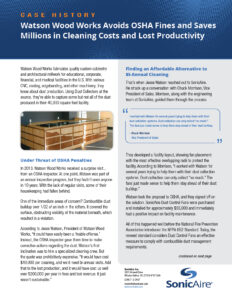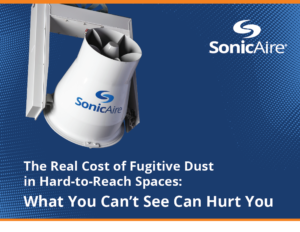Watson Wood Works
 Watson Wood Works fabricates quality custom cabinetry and architectural millwork for educational, corporate, financial, and medical facilities in the U.S. With various CNC, routing, edgebanding, and other machinery, they know about dust production. Using Dust Collectors at the source, they’re able to capture some but not all of the dust produced in their 40,000 square foot facility.
Watson Wood Works fabricates quality custom cabinetry and architectural millwork for educational, corporate, financial, and medical facilities in the U.S. With various CNC, routing, edgebanding, and other machinery, they know about dust production. Using Dust Collectors at the source, they’re able to capture some but not all of the dust produced in their 40,000 square foot facility.
In 2013, Watson Wood Works received a surprise visit… from an OSHA inspector. At one point, Watson was part of an annual inspection program, but they hadn’t seen anyone in 10 years. With the lack of regular visits, some of their housekeeping had fallen behind.
 One of the immediate areas of concern? Combustible dust buildup over 1/32 of an inch in the rafters. It covered the surface, obstructing visibility of the material beneath, which resulted in a violation.
One of the immediate areas of concern? Combustible dust buildup over 1/32 of an inch in the rafters. It covered the surface, obstructing visibility of the material beneath, which resulted in a violation.
According to Jesse Watson, President of Watson Wood Works, “It could have easily been a finable offense.” Instead, the OSHA inspector gave them time to make corrective actions regarding the dust. Watson’s first inclination was to hire a specialized cleaning crew. But
the quote was prohibitively expensive. “It would have cost $40,000 per cleaning, and we’d need bi-annual visits. Add that to the lost production, and it would have cost us well over $200,000 per year in fees and lost revenue. It just wasn’t sustainable.”
Watson Wood Works
 Watson Wood Works fabricates quality custom cabinetry and architectural millwork for educational, corporate, financial, and medical facilities in the U.S. With various CNC, routing, edgebanding, and other machinery, they know about dust production. Using Dust Collectors at the source, they’re able to capture some but not all of the dust produced in their 40,000 square foot facility.
Watson Wood Works fabricates quality custom cabinetry and architectural millwork for educational, corporate, financial, and medical facilities in the U.S. With various CNC, routing, edgebanding, and other machinery, they know about dust production. Using Dust Collectors at the source, they’re able to capture some but not all of the dust produced in their 40,000 square foot facility.
In 2013, Watson Wood Works received a surprise visit… from an OSHA inspector. At one point, Watson was part of an annual inspection program, but they hadn’t seen anyone in 10 years. With the lack of regular visits, some of their housekeeping had fallen behind.
 One of the immediate areas of concern? Combustible dust buildup over 1/32 of an inch in the rafters. It covered the surface, obstructing visibility of the material beneath, which resulted in a violation.
One of the immediate areas of concern? Combustible dust buildup over 1/32 of an inch in the rafters. It covered the surface, obstructing visibility of the material beneath, which resulted in a violation.
According to Jesse Watson, President of Watson Wood Works, “It could have easily been a finable offense.” Instead, the OSHA inspector gave them time to make corrective actions regarding the dust. Watson’s first inclination was to hire a specialized cleaning crew. But
the quote was prohibitively expensive. “It would have cost $40,000 per cleaning, and we’d need bi-annual visits. Add that to the lost production, and it would have cost us well over $200,000 per year in fees and lost revenue. It just wasn’t sustainable.”

GET YOUR FREE GUIDE:
The Real Cost of Fugitive Dust in Hard-to-Reach Spaces
What You Can’t See Can Hurt You
To help protect your workplace, we’ve compiled the following resource, The Real Cost of Fugitive Dust in Hard-to-Reach Spaces: What You Can’t See Can Hurt You. In it, we identify seven ways fugitive dust is likely impacting your facility and its profitability.
These costs go beyond housekeeping and explain why you should be preventing dust buildup to protect the bottom line, not just to stay in compliance.

